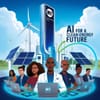Researchers at MIT argue that despite the growing energy demands of AI, the technology could play a crucial role in advancing the clean-energy transition. AI can help reduce emissions by optimizing energy use in buildings, transportation, and industrial processes. It’s also being used to improve the planning and placement of renewable energy infrastructure like wind farms, solar arrays, and energy-storage facilities.
On the power-grid front, AI models are helping grid operators manage a more variable and distributed energy supply. With the growth of intermittent renewables, supply and demand balancing becomes more complex—and AI is being used to forecast load, optimize grid operations, and even dynamically control demand (for example, by shifting EV charging or adjusting thermostats during peak times).
Another important benefit of AI is predictive maintenance: the models can analyze real-time performance data from grid infrastructure to detect anomalies, alert operators before failures, and reduce downtime. This not only improves reliability but also extends the lifetime of critical equipment.
Finally, AI is accelerating the development of novel materials for energy technologies. By combining physics-based simulations with machine learning, researchers can design better batteries, electrolyzers, solar cells, and more. In some labs, AI models suggest experiments in real time—humans validate them, robots execute them, and the feedback loop helps speed up discovery.


